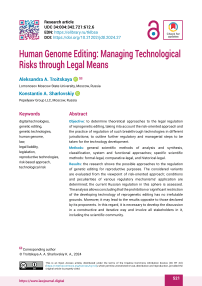Human Genome Editing: Managing Technological Risks through Legal Means
Автор: Troitskaya A. A. Sharlovskiy K. A.
Журнал: Journal of Digital Technologies and Law @lawjournal-digital
Рубрика: Государство и право. Юридические науки
Статья в выпуске: 2 (3), 2024 года.
Бесплатный доступ
Objective: to determine theoretical approaches to the legal regulation of reprogenetic editing, taking into account the risk-oriented approach and the practice of regulation of such breakthrough technologies in different jurisdictions; to outline further regulatory and managerial steps to be taken for the technology development. Methods: general scientific methods of analysis and synthesis, classification, system and functional approaches; specific scientific methods: formal-legal, comparative-legal, and historical-legal. Results: the research shows the possible approaches to the regulation of genetic editing for reproductive purposes. The considered variants are evaluated from the viewpoint of risk-oriented approach; conditions and peculiarities of various regulatory mechanisms’ application are determined; the current Russian regulation in this sphere is assessed. The analysis allows concluding that the prohibition or significant restriction of the developing technology of reprogenetic editing has no irrefutable grounds. Moreover, it may lead to the results opposite to those declared by its proponents. In this regard, it is necessary to develop the discussion in a constructive and iterative way and involve all stakeholders in it, including the scientific community. Scientific novelty: the international practice of legal regulation of reprogenetic technologies within different jurisdictions was generalized and conceptually interpreted; the natural scientific arguments in assessing the implemented regulation effectiveness were analyzed. This not only allows systematically considering the current and hypothetical risks of genetic technologies’ development and use, but also provides an opportunity to use a risk-oriented approach to the analysis of legal regulation of genome editing technologies. The next step in comprehending the phenomenon of genetic editing becomes possible. Practical significance: the study results can be used for building further constructive dialog on applying legal mechanisms to human genome editing. The study can also be a basis for iterative approach in the future discussion.
Digital technologies, genetic editing, genetic technologies, human genome, law, legal liability, legislation, reproductive technologies, risk-based approach, technological risk
Короткий адрес: https://sciup.org/14130866
IDR: 14130866 | УДК: 34:004:342.721:612.6 | DOI: 10.21202/jdtl.2024.27


